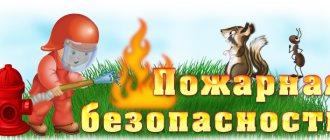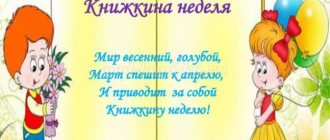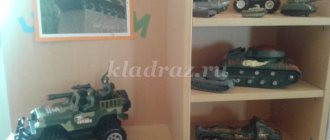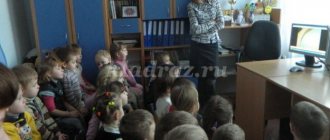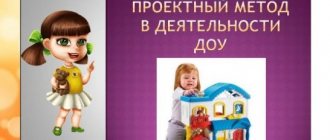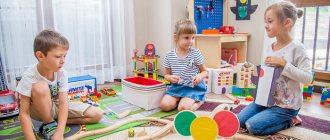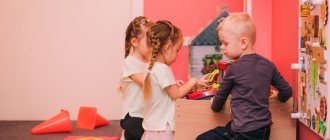Project in kindergarten for older preschoolers 5-7 years old on legal topics
Project “Great Rights for Small Citizens”
Dear residents of the “Ped-piggy bank”, I would like to bring to your attention my experience of working on children’s rights.
“Someone's legs walked along a winding path through the world. Looking into the distance with wide eyes, the little girl went to get acquainted with her rights. Nearby, my mother held her hand tightly and accompanied her clever girl on the journey. Both adults and children should know about the rights that protect them in the world.” Children’s rights today have become a “fashionable” topic, our country has embarked on the path of establishing a rule of law state, and in a civilized society, human rights and interests should be put in first place. A necessary condition for this is the awareness of people, their knowledge of their rights and responsibilities. Preschool childhood is a unique period in a person’s life, during which health is formed and personality develops. And at the same time, this is a period when the child is completely dependent on the adults around him - parents and teachers. Having started working on this topic, I set myself the following tasks: -to study literature, documents on this topic, -to acquaint parents with legal documents, with the history of the adoption of the UN Convention on the Rights of the Child and the rights enshrined in it, to give an idea of protection rights of the child, thereby increasing the level of legal culture of parents - introducing children in an age-appropriate manner to the basic documents on the protection of human rights and their rights. I planned all my work in three stages: 1. get acquainted with the documents, study the material. 2. plan work with children. 3. work with parents. Having studied the literature and documents, I found out for myself that children’s rights are a set of rights enshrined in international documents on children’s rights. The main documents include: -Declaration of the Rights of the Child -Convention on the Rights of the Child -World Declaration A declaration is an official or solemn statement. A convention is a contract, an agreement that sets out the rules forming for the parties. November 20 is considered to be the day of legal knowledge. And then there is a list of the rights of the child that are included in the convention. Then I prepared the games, selected the appropriate literature, and began working with the children.
We started with an introductory conversation, looked at the pictures, found out what rights exist and what rights we, children, have. We outlined what rights we would like to get acquainted with in detail. When getting acquainted with the “right to a name”, I held conversations: “What does your name mean”, “My full name”, held a competition “My name”, where each child, together with their parents, made a business card of their name, played games “Affectionate” name”, “Recognize by voice”, “Name is growing”.
When getting acquainted with the “right to housing”, I held conversations “The house you live in”, “My house is my fortress”, played the games “Give me your address”, “Who has the right to live in my house”, read the fairy tale “The Three Little Pigs” ", "", held a drawing competition "My Home".
Getting acquainted with the “right to live in a family,” we talked about how to take care of our loved ones and how to help them. The children talked about their families and how they relax. Family photo albums were prepared together with the parents. Conducted a drawing competition “My Family”. We played games “Mothers and Daughters”, My Family.” Homework was to make a family tree.
We finished all the work with the final quiz “Great rights for a small citizen”, remembered fairy tales, riddles, played games. When working with parents, the first stage was the use of visual information. A parent meeting was held on this topic. To identify the level of pedagogical culture, I conducted a series of questionnaires: “What kind of parent are you,” “my attitude towards punishment.” I used sliding folders. The parents showed activity, invention and creativity when doing homework: “family tree”, drawings “my family”, “compiling a family photo album”. To summarize, we can say that all this work helps to establish trusting relationships with children’s families, parents become full participants in the educational process, children feel comfortable at home and in the garden. The main idea of work on the legal education of preschool children is the recognition of the child as a full-fledged and full-fledged person: free and responsible, knowing his rights. The Convention proclaims the child to be an independent subject of law, and our task is to bring the Convention to the consciousness of children in an accessible form. And it is better to start such work with children of older preschool age. Because children 5-7 years old adequately perceive this material and manage their behavior. By the end of preschool age, the child becomes active, aware of himself as a subject of his own activities in relationships with adults and peers. Thank you for your attention.
We recommend watching:
Pedagogical project in the junior and middle groups of preschool educational institutions Research project in the preparatory group Classes with older preschoolers 5 - 7 years old. One day project Project in the middle group “Mushrooms”
Similar articles:
Development of communication skills in design and research activities in preschoolers
Project for children of the senior group “Our cheerful garden”
Creative project in the senior group on the topic “The Mysterious World of Insects”
MAGAZINE Preschooler.RF
Competitive Integrated lesson in the preparatory group Topic: “Legal education of preschool children”MDOU "Kishertsky ds No. 4" Shaikhelislamova E.Yu.
SUMMARY OF THE INTEGRATED LESSON “We want to know everything”
Goal: Formation of a holistic picture of the world, broadening the horizons of children.
Tasks:
- promote the growth of civic consciousness;
- introducing children to culture and musical art;
- development of sensory culture through musical activities;
- development of all components of children's speech in various activities.
Equipment:
- projector;
- screen;
- phonograms;
- record player;
- magnetic easel;
- forest attributes, toy.
Didactic aids:
- Newspaper “Protection of the rights and dignity of the child” ;
- Presentation “Legal education of preschool children” .
Program content:
Raising a citizen and patriot who knows and loves his Motherland, a task that is especially urgent today, cannot be successfully resolved without raising a healthy personality. The most important component of a person’s health is the state of his soul. From early childhood, children need to develop a sense of self-confidence and social tolerance, self-esteem and respect for others. All this is the basis of the legal education of preschool children.
This music lesson for children 6-7 years old is built taking into account the requirements of the “Success” and is aimed at familiarizing children with their rights.
The lesson is integrated and is for informational purposes only. The following sections of the program are integrated in the lesson: music, cognition, communication, physical education, artistic creativity, fiction.
The lesson is designed in the form of a journey through fairy tales.
Progress of the lesson:
I. Organizational moment
Children easily follow the song “Big Round Dance” and perform musical and rhythmic movements as shown by the teacher.
Teacher. Hello guys! Look how many guests we have today! Let's say hello to them. (Children say hello). Now let's say hello with our eyes. (Children say hello). Now let’s smile at each other and show that we are in a good mood. Do you want to go on a trip? Today we will travel through fairy tales, with the help of which you will learn about your rights. (Presentation) And everything that we learn about will be included in this newspaper (display) “Protecting the rights and dignity of the child . Ready to travel? Follow me then!
Dynamic exercise “On the path”
Along the path, along the path, jumping on the right leg. We are jumping on the right leg. And along the same path we jump on the left leg. We jump on the left leg.
Don't slouch, chest forward. posture alignment Wonderful people! They ran along the path, light jogging on their toes, and reached the clearing.
In the clearing, in the clearing, jumping on the spot We will jump like bunnies. They stretched sweetly, arms up, stretching, smiling at everyone.
The children sit down.
II. Main part
Teacher. What fairy tale have we found ourselves in? (music “Cinderella” ; presentation). That's right, Cinderella . Look how tired Cinderella is. What can we advise her?
Children's answers.
Teacher. What is rest? How can you relax? Pay attention to the screen, let's see what rest is like? (Presentation show)
Teacher. (Presentation) Guys, how do adults organize your vacation in kindergarten? (children answer.) Or you can just dance.
The dance “Washing” .
Teacher. Cinderella, like all children, has the right to rest. This is written down in the Convention on the Rights of the Child (presentation) and we will also add a new page to our newspaper. (pin the picture) “Children have the right to rest .
Teacher. Let's move on. Do you know how to ski? Then let's go.
Children move “on skis” . They sit down.
Teacher. Look, there's a bunny here. Let's listen to the music and find out what his mood is. (Listen to “Doll Disease” ). What is the character of the music? Do you know why she is sad? The bunny is sick and has a headache. Who can help him? Of course, Doctor Aibolit. (Presentation)
Oh, look, there’s a letter under the stump. Who is it from? Let's find out.
"Hello guys! How are you living, how is your tummy? I suggest you go to the land of Health . Did you find out who the letter is from? “What do you think health is?”
Teacher. What is health? (children's answers). We read further: “To get to the land of Health, you need not to get sick. Good luck. Aibolit."
Do you want to go to the land of Health? But for this you need to be healthy. And to be healthy, we need to learn to take care of our health. Therefore, we will do a massage to prevent colds.
Massage of biologically active zones “Cold weather has arrived .
Yes, yes, yes - the cold has arrived. Rub your palms together. Yes, yes, yes - the water turned into ice. Gently run your thumbs along your neck from top to bottom.
Doo-doo-doo - I'll slip on the ice. Use your index fingers to massage the wings of your nose. Doo-doo-doo - I'm going skiing. Rub your ears with your palms.
Dy-dy-dy - There are footprints in the snow. Place your palms to your forehead with a “visor” and vigorously rub your forehead with sideways movements - towards the middle of the forehead.
Teacher. And in order not to get sick, you need to move a lot. So you and I are going to play now. If you hear happy music, you will jump or dance, and if you hear sad music, you will walk with your heads down. Go out and play and pay attention.
Active listening (music chosen by the music director).
Teacher. But our bunny is still sick, because he does not know that, just like all children, he has the right to medical care. (presentation) Run, bunny, to Aibolit, he will cure you. (The hare leaves).
And we will add a new page to our newspaper: “Children have the right to medical care .
III. Final part.
Teacher. Well, it’s time for us to move on.
Dynamic exercise with the teacher singing.
There is a fir tree in the damp forest. Stand up straight, straight and stiff arms below, slightly apart to the sides. There is grass under the fir tree. Bend over and spread your legs wider, “stroking the grass” from side to side. There is a path on the grass, little children walk along the path, hold hands in a circle and move in a round dance.
Along the fir trees, along the birch trees, Stomping step in a circle. Often a fishing line, a hazel tree. Stomping step in a circle.
Teacher. Look, we found ourselves in several fairy tales at once. (Presentation). What fairy tales do you see on the screen? (children's answers). These tales have one thing in common - they violated the right to life and upbringing in one’s family. (conversation based on pictures). After all, every child has this right. Let's tell you how the guys live happily in their family. And we will do this with the help of finger gymnastics. Repeat after me.
Finger gymnastics.
One, two, three, four, Who lives in our apartment? One, two, three, four, five, I can count them all.
Dad, mom, brother, sister, cat Murka, two kittens, my goldfinch, a cricket and me, That’s my whole family!
Teacher. But we can tell about our family not only with the help of gymnastics, but also with song. Let's sing "The Artist's Song" .
Children perform "The Artist's Song" .
Teacher. So, let’s add another page to our newspaper: “Children have the right to life and education in their family . (attach a picture)
Teacher. (Presentation) Our journey through fairy tales has come to an end. We will once again recall the rights that apply to children. And our newspaper will help us with this. Look at it and tell your rights based on the pictures. (Children call). Well done. (Presentation) It's time for us to say goodbye. Goodbye!
| Next > |
Thematic control “Organization of work on the legal education of children”
Thematic control plan
“Organization of work on the legal education of children”
Target:
determine the level of organization of educational work in preschool educational institutions on the issues of legal education of preschool children.
| № n\n | Control issues | Suggested working materials | Deadlines | Responsible |
| 1 | Studying the level of knowledge development among preschool children about rights based on the creative and play week “Great rights of young children” |
| ||
| 2 | Assessment of professional skills of teachers. Methods, techniques, forms of work used by teachers |
| ||
| 3 | Assessment of long-term scheduling |
| ||
| 4 | Creating conditions for the formation of the legal culture of preschool children:
|
| ||
| 5 | Assessing forms of interaction with parents on this issue |
|
Map of self-analysis of the subject-developmental environment of the group
on the formation of legal culture among preschool children
| No. | Criteria | Points from 1 to 5 |
| 1. 1.1 | Richness of the subject-development environment Items that stimulate the development of universal human values (flag, coat of arms, works of art, etc.) | |
| 1.2 | Availability of didactic games and attributes for role-playing and theatrical games that implement the legal component | |
| 1.3 | Creation of a mini-library in a group (fiction, textbooks, audio, video materials) | |
| 1.4 | Creation of a card index of games for the formation of the legal culture of preschool children | |
| 1.5 | Availability of visual material on the formation of the legal culture of preschool children | |
| 2. 2.1 | Environment functionality Comprehensive ability to use objects, attributes (in all types of activities) | |
| 2.2 | Dynamic environment | |
| 2.3 | Accessibility of all items to the child | |
| 3. | Pedagogical feasibility | |
| 3.1 | Age targeting | |
| 3.2 | Individual targeting | |
| 3.3 | Pedagogical orientation of the environment | |
| 3.4 | Ensuring the comprehensive development of the child |
Visual information analysis map
for parents on issues of legal education of children
Period of execution: __________
| Age group (educators) | Visual information | Folders - moving | Help the group | Joint events | Photo exhibitions |
| I junior group “Droplet” | |||||
| First II junior group "Chamomile" | |||||
| Second II junior group "Bullseye" | |||||
| I middle group “Berry” | |||||
| II middle group "Smeshariki" | |||||
| I senior group “Zvezdochka” | |||||
| II senior group “Sweetie” | |||||
| Preparatory group "Sun" |
Conclusion:
Recommendations:
Questionnaire on legal education
Dear ____________________!
To improve the work of our preschool educational institution to protect the rights and dignity of the child, it is necessary to rely on your life and professional experience.
You can express your opinion on a number of issues in the questionnaire. Please fill it out. 1.
What international documents on the rights of the child do you know?
_______________________________________________________________________________________________________ 2.
Do you consider it necessary to protect the rights and dignity of the child in our country?
Yes, no
(underline as appropriate)
3.
If “Yes,” then what rights of the child are violated?
_______________________________________________________________________________________________________ 4.
What rights of the child must a preschool educational institution undertake to respect? _______________________________________________________________________________________________________
5.
What child rights are most often violated in the families of children in your group? _______________________________________________________________________________________________________
6.
What do you understand by legal education of children? _______________________________________________________________________________________________________
7.
Should parents be involved in the legal education of their children?
Yes, no
(underline as appropriate)
8.
At what age is it advisable to introduce a child to the legal culture of society, in particular to an awareness of human rights, including their own (underline as appropriate)
- from an early age
- from junior preschool
- from secondary preschool
- from senior preschool
- from primary school
9.
Is it possible to lead children of senior preschool age to understand such words as “right”, “freedom”, “law”, “equality”, “duty”, “international document”?
__________________________________________________________________________________________________ 10.
What means and methods should be used to form children’s ideas about human rights?
__________________________________________________________________________________________________ 11.
Do you have experience in raising children taking into account human rights?
Yes, no
(underline as appropriate)
12.
Would you like to increase the level of your knowledge about children’s rights and the legal education of preschool children?
Yes, no
(underline as appropriate)
Thanks for the help.
QUESTIONNAIRE FOR PARENTS
"Kindergarten and children's rights"
Dear moms and dads! Please answer the survey questions.
1. Are you familiar with the Convention on the Rights of the Child?_________________________________
2. How did you meet her ( underline as necessary
):
- at home, from the media;
- in kindergarten;
- from pedagogical literature;
- from other sources______________________________________________________________
3. What rights do you think a child has in kindergarten?____________________
___________________________________________________________________________
___________________________________________________________________________
4. What rights does a child have in the family?_____________________________________________
___________________________________________________________________________
5. What can you offer to monitor compliance with the rights of your children in kindergarten?_______________________________________________________________________
___________________________________________________________________________
___________________________________________________________________________
6. Is a permanent representative for children’s rights needed in a preschool institution?
____________________________________________________________________________
7. Do you know addresses, telephone numbers of organizations ( if possible, please indicate
), where can I turn to regarding the protection of the rights of a child in a difficult situation?_________________________________________________________________
Thank you very much!
Sincerely, the administration of MBDOU "Kindergarten No. 9"
List of sources used:
1. https://www.ds27.edusite.ru/p47aa1.html
2. https://rudocs.exdat.com/docs/index-391236.html?page=6
The full version of working with applications is available.
